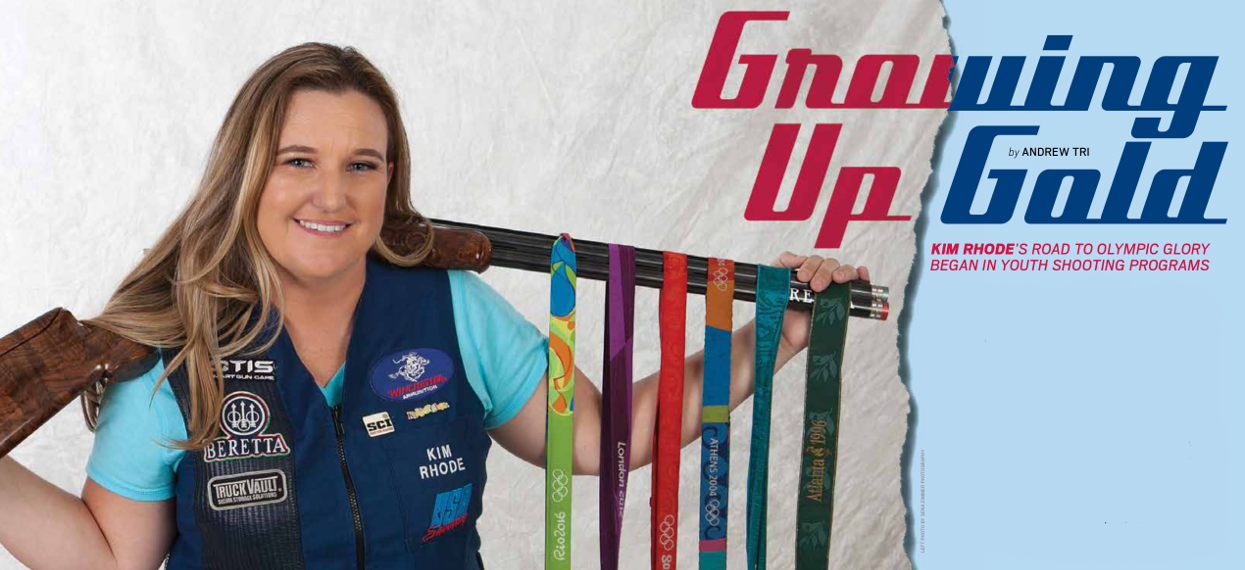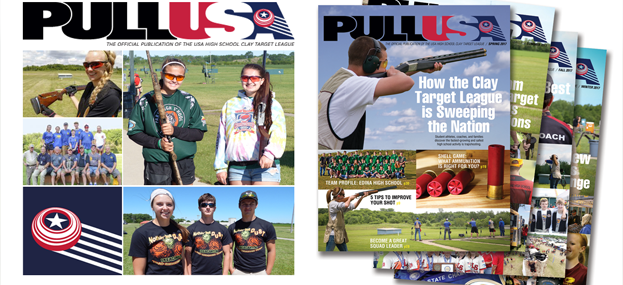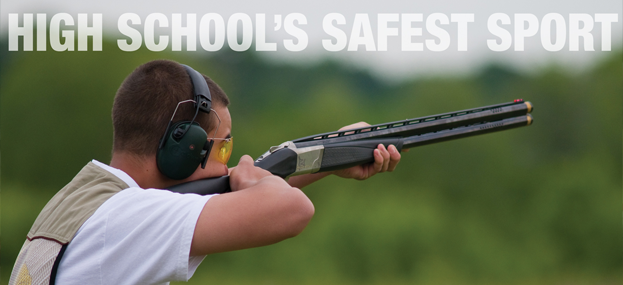VINCE HANCOCK’S JOURNEY FROM GEORGIA TO OLYMPIC STARDOM
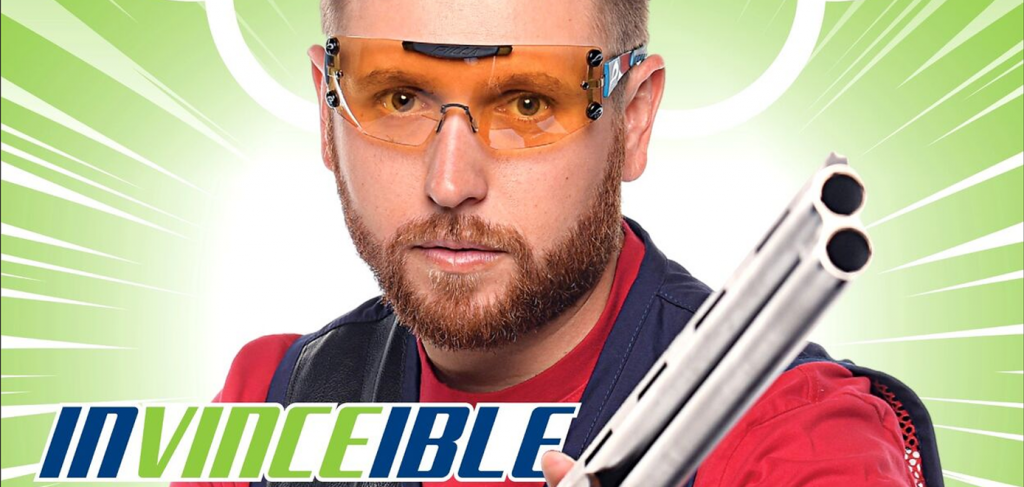
When Vincent Hancock showed up to the 2005 World Cup in Changwon, Korea as a 16-yearold, a lot of people dismissed him. Don’t expect too much, they said. Just have fun. Then he set a world record.
“So people were like who is this kid?” recalled Hancock. “And they said OK well this is never going to happen again. Don’t think you are going to come out and do this every time.” They didn’t know who they were dealing with.
Since skeet became an Olympic event in 1968, no other athlete had ever won gold more than once. Then along came Vincent, who shocked the world with a record-breaking gold medal performance in Beijing at the age of 19. Four years later, he won Olympic gold again in London. But it wasn’t always smooth sailing for the Eatonton, Georgia boy. As he ramps up
for his fourth Olympics this summer in Tokyo, Vincent shared his journey from eager youth to dominant teen and now humble father, student, coach and entrepreneur.
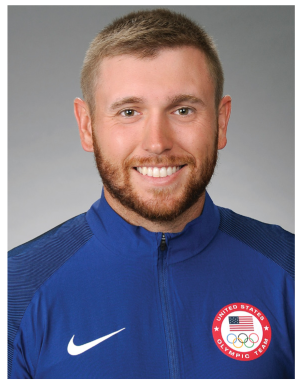
THE SPARK
Vincent grew up a lover of baseball, but his dad, Craig Hancock, and older brother, Matthew, shot competitively. Craig also coached the local 4-H shooting sports team. When Vincent turned 10, dad took him to South River Gun Club in Covington, Georgia, for his first round of skeet. He quickly progressed to sporting clays. “I loved it. I thought it was so much fun,” Vincent said. A couple years later Vincent was at a 4-H state championship with his dad. Still too young to compete, he was just hanging out with the team when a gentleman came by trying to drum up interest in the Olympic discipline of shooting in Atlanta, where the 1996 Olympic Games were held.
The Hancocks drove up to Atlanta the following weekend, where Vincent shot valiantly the first day, and terribly the next. Something sparked inside of him. “It was on the drive home that night that I told my parents I wanted to go to the Olympics and I wanted a gold medal,” Vincent said.
THE FOUNDATION
Three months later, Craig, who was a homebuilder, built a skeet field in the Hancock backyard. Vincent started shooting every single day.
“Looking back on it, knowing I had that opportunity, it was really neat,” said Vincent, who now lives, trains, and coaches fellow Olympians Austen Smith and Amber English in Fort Worth, Texas. “It’s crazy to think about what I had at my hands to be able to succeed, and how few people have that opportunity.”
Craig was a really good trap shooter, but didn’t know much about the Olympic discipline. So Vincent took it upon himself to find videos online, studying the likes of American Olympians Todd Graves and Shawn Dulohery, along with Italian Olympic champion Ennio Falco. He’d sprinkle in his knowledge from sporting clays, and, voila. “So it was just kind of a morphing of a bunch of different techniques and a lot of different things that didn’t work,” he said. Then Craig was hired as the contractor for the
gun club in Eatonton, where he quickly realized just how much he loved shooting sports. Craig dropped construction altogether, bought the club and became the general manager. As Craig started to bring in different coaches to the facility, young Vincent took advantage. “We couldn’t afford the lessons, but what I would do is go out and listen to them coach, and on the off chance that they had a little time and they were willing to spend
it with me, I just wanted to shoot with them,” Vincent said. “They taught me how to shoot pull-away, and how to shoot pass-through. They taught me how to shoot sustained and taught me how to shoot trapping a target, or collapsing into the target. “That’s the biggest thing about my learning phase that I can attribute to a lot of my success—being able to understand all these different concepts and apply them in sporting clays, and then transition them over to the skeet field.”
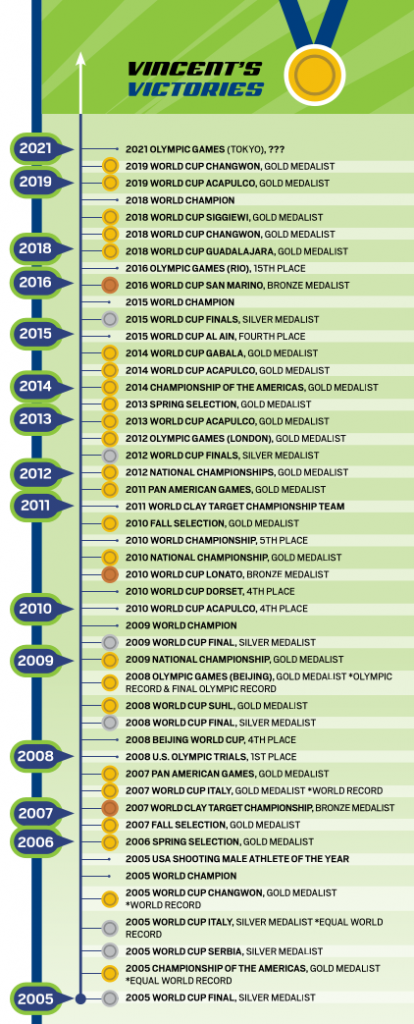
THE RISE
Vincent won his first match in 2004, the Miami Cup, at the age of 14. And after that, “I went on a tear.” In 2005, he took everyone by surprise, not only qualifying but winning and setting world records at his first World Cup in Changwon. He didn’t take kindly to being viewed as a one-hit wonder.
“That was not me. My expectations and competitiveness were extreme, to say the least,” Hancock said. The rest of that year, Vincent went to seven international matches, including Korea, and won four gold and three silver medals while setting a handful of world records. “I kind of went crazy that year,” he said. The Army took notice and Vincent joined the 12-person U.S. Army Marksmanship Unit. Stationed at Fort Benning, he trained seven days a week, driving home to shoot with dad on the weekends, and continuing to rack up victories. Then he made the 2008 U.S. Olympic Team. Riddled with nerves and drenched with sweat in the Beijing heat, he fulfilled his dream with a record-breaking, gold medal shootoff victory at age 19.
THE FLAG
To this day, opening ceremonies in Beijing is his favorite memory.
“Everybody always assumes the best part of the Olympics is getting the gold medal and having it hung around your neck, watching the flag being raised and listening to the anthem,” Vincent said. “That’s amazing—truly. But the most iconic moment of any athlete’s life is walking into opening ceremonies. “As we’re walking there, and it takes hours to get there, the hallway under the stadium is pitch black inside. We can’t see anything. I’m maybe 13 rows behind the flag.
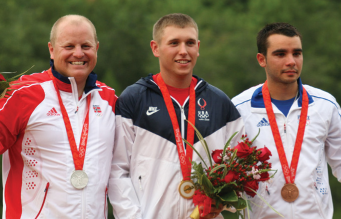
We’re walking as a group and the energy is getting insane as we get closer. The athletes are hopping up and down, hooting and hollering. The crowd is cheering. It’s the loudest experience I’ve ever had. “As we’re getting close and they call the United States, as soon as the flag bearer walks out, the flag bursts into colors. It’s the brightest red, white, and blue you’ve ever seen
in your life. They start chanting U-S-A and it’s just an unbelievable experience and nothing else in the world can rival that.”
THE STRUGGLE
Vincent rode that high until he hit a wall in 2011. “I shot the worst match of my life in Slovenia. I was sick of traveling. I had a young baby. I said I’m done,” Vincent recalled. “My wife said, ‘No, no, just stop, let’s get home and
we’ll talk about it.’ It took a few months for me to realize that I had never reset any goals after 2008. I didn’t have anything that I was driving myself towards.” After taking time off and setting new goals for himself, he reemerged better than ever. In a jacket and rain pants, Vincent won the 2012 Olympic gold medal in London, this time by a comfy two-shot cushion.
After cementing himself in history with his back-to-back Olympic golds, he fell into a similar pattern of competing well for a couple years before crashing. Unfortunately this time the crash culminated at the 2016 Olympics in Rio with a 15 th place finish. “I just felt off the entire year,” he said. “I was really down on myself after Rio. After that I just realized I wasn’t having any fun. I was pushing myself too hard and put too much pressure on myself. Something needed to change. I realized you have to enjoy it and you
have to go out and have fun. That was my change in attitude after 2016.”
Vincent took seven months off after Rio, searching for the spark that lit his career.
THE STAY AT HOME DAD
Vincent’s wife, Rebekah, went back to college in the nursing program at Texas Christian University (TCU). That meant the three-time Olympian needed to step up where he was needed most. “This last semester I was doing everything,” said the father of two girls. “I picked the kids up and dropped them off. I made them breakfast and I cooked dinner every night. I
drop the kids off in the morning and I’m at the gym for the next two hours. From the gym I go straight to the range.” Vincent is not only proud of his wife, but inspired by her. He’s now finishing up his degree with DeVry University and was recently accepted into TCU’s executive MBA program. He’ll start classes this fall. Vincent’s ultimate goal is to build, own, and operate a new state-of-the-art shooting facility. Last year, he received a grant to build in Fort Worth. The plan is to have it up and running within the next year or two. Several years down the road, he aims to have it fully
outfitted for the Olympic discipline, ready to host World Cups, and much more. “I’ve explained the dire need for facilities here in Fort Worth,” he said. “We just don’t have enough ranges for people that want to shoot. We’re having to turn away kids and turn away high school teams that want to start because there’s just nowhere to practice.”
THE FUTURE
Vincent has a sincere passion for growing the sport. “One of my highest priorities is to have this facility open every single day for kids and for teams to come in and shoot,” he said. “I’m not going to turn away kids that want to come out here and shoot just because someone else gets mad there’s a group of kids on the field. Our future is the youth.” He strongly believes in the USA Clay Target League as a driving force for the industry. “The USA Clay Target League is doing a fantastic job trying to grow the sport,”
Vincent said. “We need to grow this in every state and have facilities that embrace it as well. That’s how we’re really going to grow. “The clay target shooter is putting a lot more into the whole industry than just your
hunter who goes out and shoots maybe a couple deer each year. The clay target shooter is going to shoot 50-100 cases of shells each year. Then they’re going to get excited and go hunt. Let’s grow it through shooting sports because we can get into urban centers and reach people that may not be interested in hunting yet, but we teach them what this is all about: safety, history and opportunity.”

THE ROAD TO TOKYO
But there is just one thing at the forefront of Vincent’s mind right now: Tokyo. After taking seven months off and acquiring his new shotgun, he was raring to go. Then the pandemic hit, and the Olympics were postponed a full year to July 2021. Vincent didn’t want to make the same mistakes, so he took another nine months off to reset. Now he hopes to peak when it counts most. “I want to get that feeling where I step onto the range and there’s literally no doubt in my mind that I’m going to win. Because when you feel that way, other people see it too,” Vincent said. “I know that I’ll get there and I’ll be ready when Tokyo comes around.”
VINCENT’S KEYS TO VICTORY
VINCENT HANCOCK’S TIPS FOR NOVICE, JUNIOR VARSITY, AND VARSITY STUDENT ATHLETES
NOVICE
I’m still stressing the basics to Austen (Smith), who’s a world record holder and Olympian. If I had one thing to say when you’re first starting out, learn how to look at a target. You want to see the front leading edge, whatever it is—going up, down, right, or left— look at that and see it as clearly as possible. Match the speed of the target. When you’ve matched the speed and you see the target clearly, that’s when you pull the trigger.
JUNIOR VARSITY
MOUNTS -Work on your mounts. A lot of people really have this funky mount that they get into—they’re dropping their shoulder back or lifting their head or poking their head way down. If you’re just standing straight up and you have the shotgun across your body, and you’re looking to your left (as a right-hander), finding your natural point of alignment is critical. How you find your natural point of alignment is if you’re standing with your feet shoulder-width apart, and they’re parallel. Your left pinky toe (front foot) and right heel (back foot), if you have a stick where you can line those up, where that points to is your natural point of alignment. You want to put your natural point of alignment where you want to break the target.
VARSITY
ROUTINE – Work on your routine. The routine is the most critical part in getting you that last 5% to go from 95% to 100%. if you can do the same thing over and over and over again, it creates repeatability, and repeatability breeds success. because you know the more you do something, the better you get at it.
But if you go out there and your hold points are different every time, your eyes are in a different spot, and your break points are in a different spot, your foot position is in a different spot, all of those things change the outcome.
You’re trying to make the outcome as simple as possible. Set yourself a routine where you can check off every single step of it, each time, before you call for the target. It’s called a pre-shot routine. When you accomplish that, you set yourself up for success and you can repeat what you now works.
3 SKEET LEADS
VINCENT HANCOCK EXPLAINS THE THREE DIFFERENT TYPE OF SKEET LEADS.
SWING-THROUGH:
Start your barrel from behind the target. Sweep through the bird. Get in front of the target and pull the trigger while still moving your barrel away. Using the swing-through method isn’t my favorite because of its inconsistency. As your barrel passes through the target, you lose sight of
it. But you will need to learn how to use this method, because sometimes you get beat by the target. And to break it, your barrel must pass through it.
SUSTAINED LEAD:
Get in front of the target at the appropriate lead. Follow the target and pull the trigger while maintaining its follow-through. This is the most consistent lead on the skeet field, and because of that, it’s also my favorite. Finding the correct lead, and how much lead that is, depends on how far the target is away from you, and how fast it’s moving.
PULL-AWAY:
Match the speed of the target, and then slowly accelerate away from it at about 1 mph faster than the target is moving. On both the skeet field and the hunting field, this is commonly used because of its consistency. I recommend you try the pull-away method over all the others because it’s consistent in both shooting sports and hunting.

